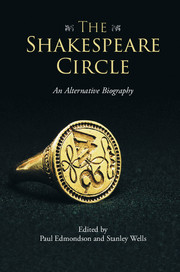Book contents
- Frontmatter
- Contents
- List of illustrations
- List of contributors
- Preface and acknowledgements
- General introduction
- Part I Family
- Part II Friends and Neighbours
- 12 A close family connection: the Combes
- 13 Schoolfriend, publisher and printer Richard Field
- 14 Living with the Mountjoys
- 15 Ben Jonson
- 16 Richard Barnfield, John Weever, William Basse and other encomiasts
- 17 Last things: Shakespeare's neighbours and beneficiaries
- Part III Colleagues and Patrons
- Closing remarks
- Afterword
- Index
- References
16 - Richard Barnfield, John Weever, William Basse and other encomiasts
from Part II - Friends and Neighbours
Published online by Cambridge University Press: 05 November 2015
- Frontmatter
- Contents
- List of illustrations
- List of contributors
- Preface and acknowledgements
- General introduction
- Part I Family
- Part II Friends and Neighbours
- 12 A close family connection: the Combes
- 13 Schoolfriend, publisher and printer Richard Field
- 14 Living with the Mountjoys
- 15 Ben Jonson
- 16 Richard Barnfield, John Weever, William Basse and other encomiasts
- 17 Last things: Shakespeare's neighbours and beneficiaries
- Part III Colleagues and Patrons
- Closing remarks
- Afterword
- Index
- References
Summary
Shakespeare was certainly well known to his contemporaries as an author, even if he was not uncritically celebrated. The three Parnassus plays, satirical works performed at St John's College, Cambridge, around the end of the sixteenth century, have a clear understanding of Shakespeare as a poet and playwright. The plays reflect on the progress of two aspiring poets, Philomusus and Studioso, eager to learn their craft so that they can spend their lives in contemplation and composition on the celebrated hill of Parnassus, home of the Muses. Much of the action in The Pilgrimage to Parnassus, The Return to Parnassus and The Return from Parnassus: The Scourge of Simony (the only one of the plays to be published in 1606) satirises poor writing and the vices that lead to such writing. Hence there are characters called Stupido, who, as his name suggests, lacks the intelligence necessary to write good poetry; Amoretto, who is rather too taken up by the charms of the ladies to write well; and Luxurioso, who is excessively concerned with physical pleasure. There is also Gullio, rather impressionable and addicted to the latest fashion, who is determined to ‘worship sweet Mr. Shakespeare’ (Anon. 1949, p. 192). Gullio refers to Shakespeare as ‘sweet’ throughout the plays, a sign that Shakespeare is considered to be adept at producing mellifluous Ovidian verse but that, in the author's opinion, he lacks the true seriousness of a major poet such as Edmund Spenser, who is praised throughout as the best English poet since Chaucer. In the most extended discussion of contemporary poetry near the start of the third play, the sensible Judicio makes explicit what has been implicit in Gullio's penchant for Shakespearian verse: viz., that the author thinks of Shakespeare as a talented crowd pleaser who has not yet made his mark as a major writer:
Who loves not Adon's love or Lucrece's rape?
His sweeter verse contains heart-throbbing line,
Could but a graver subject him content,
Without love's foolish languishment
(Anon. 1949, p. 244)Judged against the very highest standards Shakespeare is a skilful lightweight who has the capacity to do rather better.
The author knows that Shakespeare is also a playwright: Gullio quotes a passage from Act 2 of Romeo and Juliet. Towards the end of the final play Will Kemp and Richard Burbage appear.
- Type
- Chapter
- Information
- The Shakespeare CircleAn Alternative Biography, pp. 199 - 212Publisher: Cambridge University PressPrint publication year: 2015
References
- 1
- Cited by



